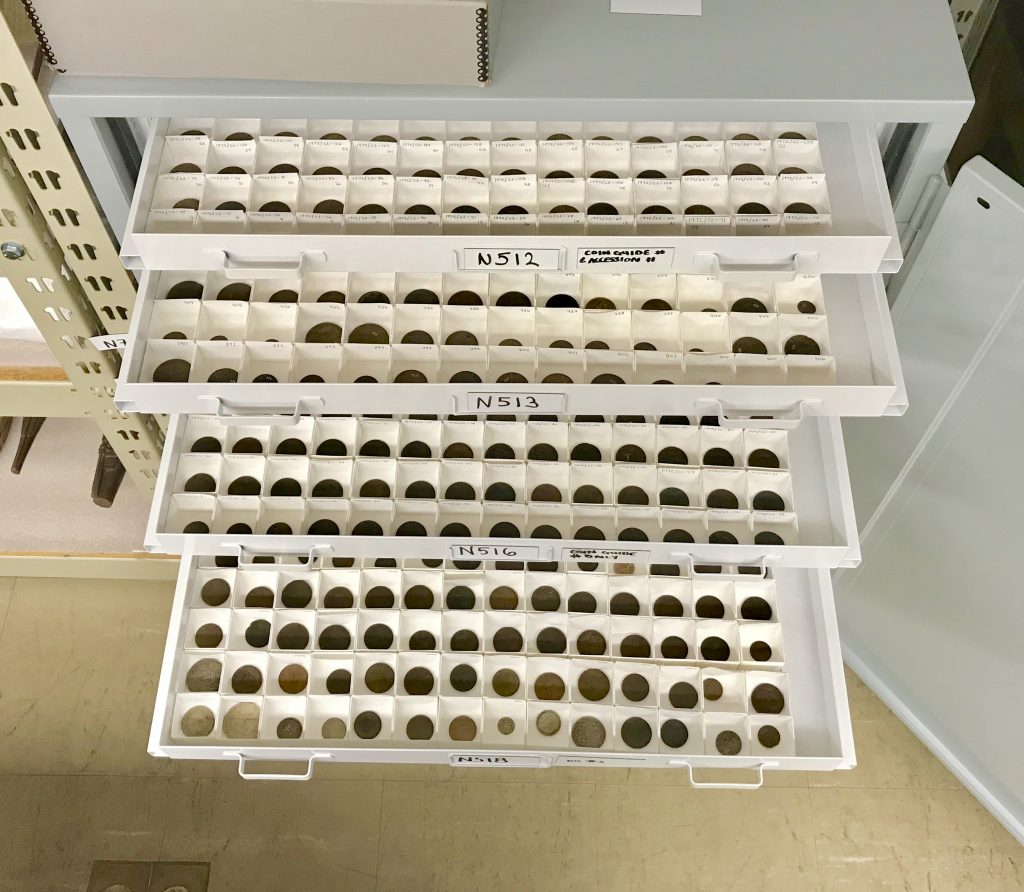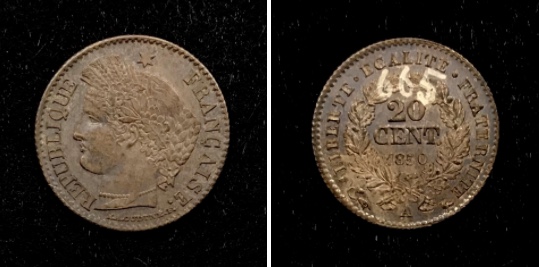Last semester marked the beginning of the Wesleyan Archaeology and Anthropology Collections’ great numismatic undertaking—this semester, the project is in full swing. With the additional help of two new intrepid student workers, the collections staff has been making some serious headway in the long and arduous process of cataloging all four thousand or so of the coins recently recovered from Earth and Environmental Sciences. A few weeks ago, we reached an important milestone: We cataloged our 1000th coin!
The event was (un)surprisingly anti-climactic. It didn’t happen during my shift; the coin was researched, labeled, acceded, placed into a box and dropped into a drawer, and the moment passed without a hint of pomp and circumstance. But celebrating these occasions is crucial for maintaining commitment to and enthusiasm about enormous projects like this numismatics catalog, and the more I learn about these coins, the easier it is to notice interesting and unique elements in all of them. So here is a love letter to the 1000th entry in our spreadsheet.

Our coin #1000 is actually coin #665 in the antique-looking coin accession book from the old Wesleyan Museum. Although we do encounter groups of coins with contiguous accession numbers, there are often large gaps between those groupings within the same drawer, and there was no way to predict which section of the accession book would house our 1000th coin. It so happens that this coin comes from a series of 18th and 19th century French numismatics. Already, this particular time period makes the coin interesting, because the century between 1770 and 1870 saw an enormous amount of political turmoil and turnover in France. Without wasting too much time on a history lesson I am not qualified to give, here is a brief chronological rundown:
- 1715-1774: The reign of King Louis XV
- 1774-1791: The reign of King Louis XVI, who was executed in 1793
- 1789: The outbreak of the French Revolution
- 1792-1804: The First Republic
- 1804-1814: The First Empire under Napoleon Bonaparte
- In 1814 Napoleon was exiled to the island of Elba, but he returned to France in 1815 and briefly resumed rule for a period known as the Hundred Days
- 1815-1830: The Bourbon monarchy was restored
- 1815-1824: The reign of King Louis XVIII, following the Hundred Days and his second restoration to the throne
- 1824-1830: The reign of King Charles X
- 1830: The outbreak of the July Revolution
- 1830-1848: A constitutional monarchy was established under King Louis Philippe I
- 1848: Outbreak of the February Revolution
- 1848-1852: The Second Republic, with Louis Napoleon as president
- 1851: Louis Napoleon staged a coup d’état
- 1852-1870: The Second Empire under Louis Napoleon, now Emperor Napoleon III
In our collection, we have encountered coins from nearly every period of this eventful historical moment. The coin in question, number 1000, comes from one of the shorter chapters—the Second Republic—but its story begins five decades earlier. As a part of an effort to redesign all forms of measurement in base-10, the First French Republic introduced the franc as the primary unit of currency in 1795. The franc was, in turn, broken up into 10 décimes and 100 centimes. Although coins of various denominations were minted and discontinued in the decades between the First and Second Republics, the denominational structure remained until the 1960s and the introduction of the new franc.
Coin #1000 is a 20-centime piece from the year 1850. Its obverse depicts a bust in profile facing left below the phrase “Republique Française” and its reverse displays the value and date within a wreath, surrounded by the familiar phrase “Liberté Égalité Fraternité.”

The Second Republic lasted a scant five years, and its inception essentially marked the beginning of its downfall—yet, even in those five years, French coins were minted. Louis Napoleon, grandson of Napoleon Bonaparte, staged a coup d’état in 1851, a mere three years after being elected president of the new republic, then retroactively held a plebiscite in which voters were asked if they agreed with his seizure of power. He declared himself Emperor Napoleon III a year later, in December of 1852, after which the phrase “Republique Française” was no longer minted on French coins. But in 1850, even as Louis Napoleon was planning his coup, this 20-centime piece was minted. And, over 150 years later, it found its way to Wesleyan.
Sometimes, this numismatics collection feels like a map of the world. I’ll put down a coin from Brazil and pick up the one sitting right next to it, only to discover that it’s from Korea, or Great Britain. But these French coins have reminded me that numismatics can also tell the story of a single place over a long period of time. France’s economy has a tangible historical record built into its framework, and this coin is a part of it. But it’s also coin #1000 for us, coin #665 for the Wesleyan Museum, and, in a day’s work, it’s kind of just another coin.
Back into the numismatic depths I go.
By: Sophia Shoulson, ’18
Sources:
https://www.britannica.com/place/France
https://www.britannica.com/topic/Second-Republic-French-history


